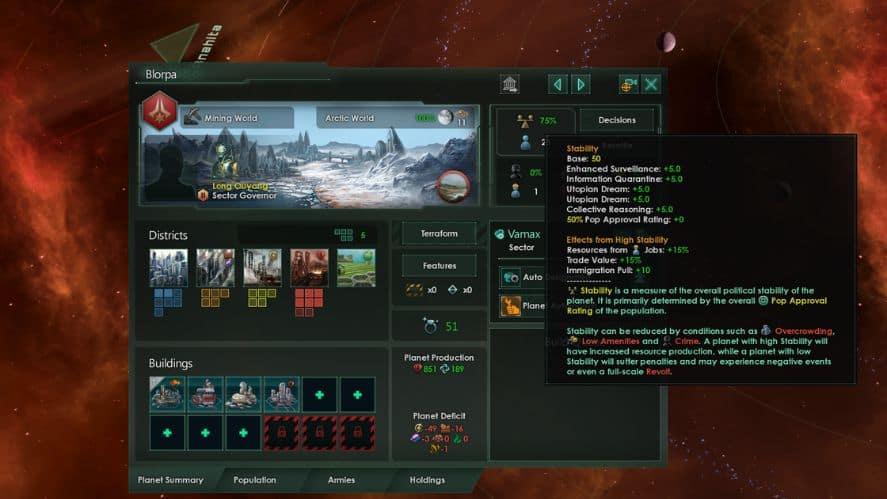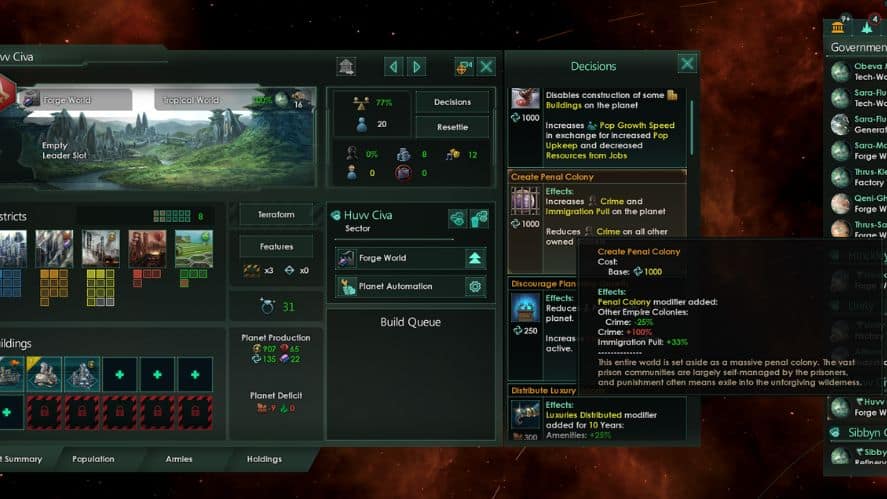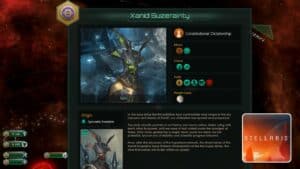This planetary management guide was designed from the ground up to help you make more sense of how planets work in Stellaris. It will equip you with the tools you need to go out and create some great worlds for your empire.
There are so many different mechanisms to manage in Stellaris; some are minor, such as picking traditions or enacting edicts. Other mechanics are larger in scope, like ship design or planetary management.
Recommended Read: How to Close Borders in Stellaris
Planets are what your economy will live and die by in Stellaris, and taking the time to learn all you can about this will serve you well. Don’t expect to be an expert right away; that will come with time and experience.
To manage a planet effectively in Stellaris, you must ensure the population is happy, manage crime, enact planetary decisions, construct buildings, designate districts, and plan its future progress.
Table of Contents
Planetary Management Guide for Stellaris
Managing planets and supporting their development is one of the most complex and engaging game mechanics that Stellaris has to offer. So much so that you could make an in-depth guide for most of the small parts that make up the planetary management sphere.
The focus of this guide is to provide a brief introduction to the most important aspects of managing a planet.
Before getting into those mechanics, we should first explain why this system is so important to producing a great empire.
Planets are celestial bodies found in almost every system in Stellaris. Some of these are fit for colonization by space faring empires to expand their production potential, influence, and population.
Planets are where pops live, allowing them to work jobs that improve the economy of your empire.
Each planet has a finite amount of space and output potential. Therefore, the more planets you can manage well, the more powerful your empire could become.
Characteristics of a Planet
Every planet that is colonizable will have a few characteristics that are important. First is the size of the planet; the larger a planet, the more districts you will be able to build.
Next up is the habitability score. The game displays it as a percentage and also color-codes it for us. There are three climate types: dry, wet, or frozen. Each of these climates is then split into three climate types.
Arid, desert, or savanna for dry planets. Ocean, continental, or tropical for wet worlds. And alpine, arctic, or tundra for frozen worlds.
The homeworld you selected at the beginning of the game will belong to one of these categories.
The more planets’ climate matches a pop’s home world, the higher the habitability score will be. Obviously, aliens that live on a desert planet will not fare well on a snow-covered, frozen world.
As a result, a low score results in various happiness, production, and upkeep costs for your pops.
There’s a lot more to know about planetary characteristics, such as planetary features, modifiers, and blockers. For this whistle-stop tour, size and climate are all you need to know when learning the ropes of planetary management.
Pop Happiness
Assuming you already know how to colonize a world, the next step is ensuring the pops you have living there are happy. Every pop on a planet has a happiness score, which is again expressed as a percentage.
It goes without saying that a high happiness rating is good, and a low rating is bad. A high rating reduces the risk of rebellion, crime, increases governing ethics attraction, and increases the approval rating.
What determines happiness depends on a lot of factors. Whether your pops have housing, if they are slaves, living standards, habitability score, active edicts, faction approval rating, planetary modifiers, and so much more.
Having negative or positive happiness can trigger gameplay events such as revolts or inspired scientists.
While low happiness is never the end of the world, steps should sometimes be taken to repair low morale on your worlds if possible.
Planet Stability
This stat is at the top of the main page of the planet menu. Represented by a set of scales and, you guessed it, expressed as a percentage. The base score is 50%, which represents a planet doing fine.

Lower scores are a sign of political upheaval, government corruption, civil unrest, and a lack of cohesion among the planet’s populace.
Higher scores represent the planet turning into more of a utopian society, a free haven, if you will.
For every one percent you go above the base of 50, the planet receives bonuses to resource production, trade value, and immigration pull. Points below 50 imply much stronger penalties for those same stats.
Low stability can even lead to planetary unrest events, and if below 25%, it can lead to a full-blown planetary revolt.
Stability depends on pop housing availability, amenities, crime, and pop happiness. If you notice your stability declining on a planet, improve those stats, and it will soon climb back up.
Planetary Buildings and Districts
These are what produce the jobs for your pops to carry out. Without a doubt, the most important factor when managing planets is the buildings and districts you put on them.
Districts are macro-level structures; these are large areas filled with various buildings. They represent large hubs of trade and commerce. You could imagine them as specialized areas in our own world.
For instance, the Strip in Las Vegas would be a trade district. The famous rice terraces in East Asia are great examples of food districts.
Any city you can think of with large, sprawling suburbs could be a housing district in Stellaris.
Buildings are, more specifically, single structures. Think of these as single specialist buildings supported by work going on in your districts.
Some good examples in our own world would be things like the Hadron collider, which improves our science research. Or perhaps the Parken Stadium in Denmark, which provides entertainers and amenities for the local population.
You can build a number of districts equal to the planet’s size, plus or minus any modifiers you may have. These can come from traditions, technology, or other sources.
When it comes to building, you have 12 building slots that unlock as your population increases. Extra building slots are rarer, but you can obtain them through events, special projects, or planetary modifiers.
Crime and Deviancy
For all intents and purposes, crime and deviancy are the same thing. Crime is a stat standard empires accrue, while hive-mind empires produce deviancy. Machine intelligence pops will never produce crime or deviancy.
Pops will turn to crime for a host of reasons. They may be unhappy with their living situation, planetary events may force them into a life of crime, or a criminal syndicate empire may be promoting that lifestyle.
Crime starts at a rating of zero and, when accrued, cascades into many negative effects for your planet. Having high crime rates forces your pops to work criminal jobs, which reduces your planet’s trade value and pulls them away from other, more important jobs.
Crime can be fought by using the planetary decision system or by having your pops work as enforcers or hunter-seeker drones.
Producing criminal jobs isn’t the only negative consequence of not dealing with crime. It can also lead to devastation on the planet, lower stability, further trade value penalties, and less resource production.
Removing crime from planets is a long-term project, and in most cases, it is not an easy fix.
Planetary Decisions
To focus your planet more or to rectify issues that have appeared, you can enact planetary decisions. Nations on our planet do things like this all the time, such as distributing government aid or protecting endangered species.
Similar decisions exist in the game, but for the most part, planetary decisions come with a cost and provide some form of benefit.
This can range from a tiny level, like making a deal with crime lords, to huge-scale decisions that turn the planet into a worldwide prison.

There are so many planetary decisions that creating a list would be pointless. The Stellaris Wiki is the best place to go for a full list of the well over 200 potential decisions there are.
There is so much that goes into effectively running a planet, and it would never be practical to cover it all in one guide. There are tons of guides available on Gamer Empire to help answer any further questions you may have, as well as the Stellaris Wiki too.
This is everything you need to know about the most important aspects of planetary management in Stellaris.
If you have any questions or suggestions for this guide, please let us know in the comments section below. As always, have fun managing planets in Stellaris.




